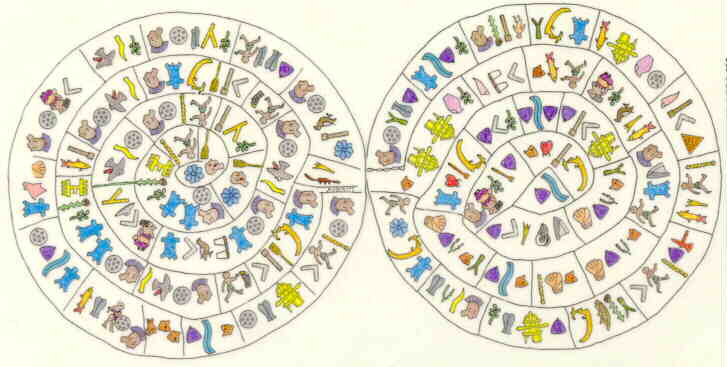 The famous spiral disk found in Phaistos, Crete in 1908 has long defied efforts to translate it or even to identify the language in which it is written or what kind of a document it might be (it is here in color to aid analysis). Though many scholars and amateurs have proposed theories and even translations, none has seemed persuasive to the great majority of observers. A skeptical view holds that the disk is a forgery, but most scholars reject this. Many scholars agree that the small sample of language in the disk makes a breakthrough very unlikely unless and until other samples of the writing are found.
The famous spiral disk found in Phaistos, Crete in 1908 has long defied efforts to translate it or even to identify the language in which it is written or what kind of a document it might be (it is here in color to aid analysis). Though many scholars and amateurs have proposed theories and even translations, none has seemed persuasive to the great majority of observers. A skeptical view holds that the disk is a forgery, but most scholars reject this. Many scholars agree that the small sample of language in the disk makes a breakthrough very unlikely unless and until other samples of the writing are found.
The only object similar to the disk is the Etruscan Magliano disk of the 5th Century B.C., whereas the Phaistos disk is generally dated no later than 1000 B.C. and often much earlier.
There is, however, a new theory that could make sense of the Phaistos disk. Even if this theory doesn’t lead to a translation, it could tell us what language the disk is written in and what kind of a document it is. Knowing those two attributes of the disk might prove at least as useful for ancient history as being able to read the entire text itself.
The new theory is called The Trojan Origin of Roman Civilization (TORC). It argues that a Greek naval blockade during the Trojan War kept Trojans on the European shore from intervening, and that they subsequently escaped to Italy where they were called Etruscans. According to TORC, raiding parties of Trojans had previously been among the Sea Peoples of Egyptian history and the Philistines. It would therefore make sense that they also attacked Crete, leaving the Phaistos Disk behind.
So we can state what must be recognized as a provisional proof that the Phaistos disk was Trojan thus:
First, if the Etruscans were indeed Trojans, then the fact that the Magliano disk is the only object resembling the Phaistos disk clearly suggests that they came from the same cultural tradition, though perhaps some 700 years apart—i.e., that the Phaistos disk is Trojan.
Second, aside from the general shape and spiral pattern of the two disks, most scholars consider that the lettering on the Phaistos disk is to be read starting at the parallel spot and in the same direction as the writing on the Magliano disk. To the extent that these arguments are independent of the Magliano disk, they constitute a logical pattern that connects the two disks aside from their obvious resemblance.
Third, many scholars consider that the Phaistos disk is written in a syllabary. According to TORC, the Trojan language had an Ugric grammar, and therefore belonged to the Ural-Altaic family. Ural-Altaic languages are well suited to the use of syllabaries, as can be seen in Japanese Katakana script.
Fourth, the words at the end of the Phaistos disk seem to be shorter than those at the outset, which would match the pattern found in various Ural-Altaic languages where the terminal words are frequently verbs of being or doing following longer participial and gerundive constructions.
Fifth, the frequent “warrior” plus “shield” characters at the beginning of words in the Phaistos disk could be a kind of religious incantation—perhaps an honorific name of individual gods, as with saints in Christian religious documents. The Magliano disk, which has been partly translated, is known to include the names of various Etruscan gods. So a sign of incantation or honorific names would tend to lead us to believe that the Phaistos disk contains a religious text.
Sixth, some researchers have argued that the disk’s characters are derived from Luwian hieroglyphs, yet they are not sufficiently close to Luwian to permit a reading. This would be consistent with a situation in which the Trojans borrowed the concept of writing with such characters as well as some of the characters themselves from the neighboring Luwians.
#2-6 in this “proof” are mere straws in the wind. But #1 is not. It strongly suggests that the Phaistos disk is a Trojan religious document—if credence is given to the TORC theory. Therefore, it seems advisable to term these six points a provisional proof and to search for further patterns in the two disks, in Etruscan religious writings, and in Etruscan vocabulary and grammar that can lead to a more definitive proof.
*****
Kenneth J. Dillon is an historian who writes on science, medicine, and history. See the biosketch at About Us. For further detective work on ancient and modern history, see his The Knowable Past (Washington, D.C.: Scientia Press, 2018).

